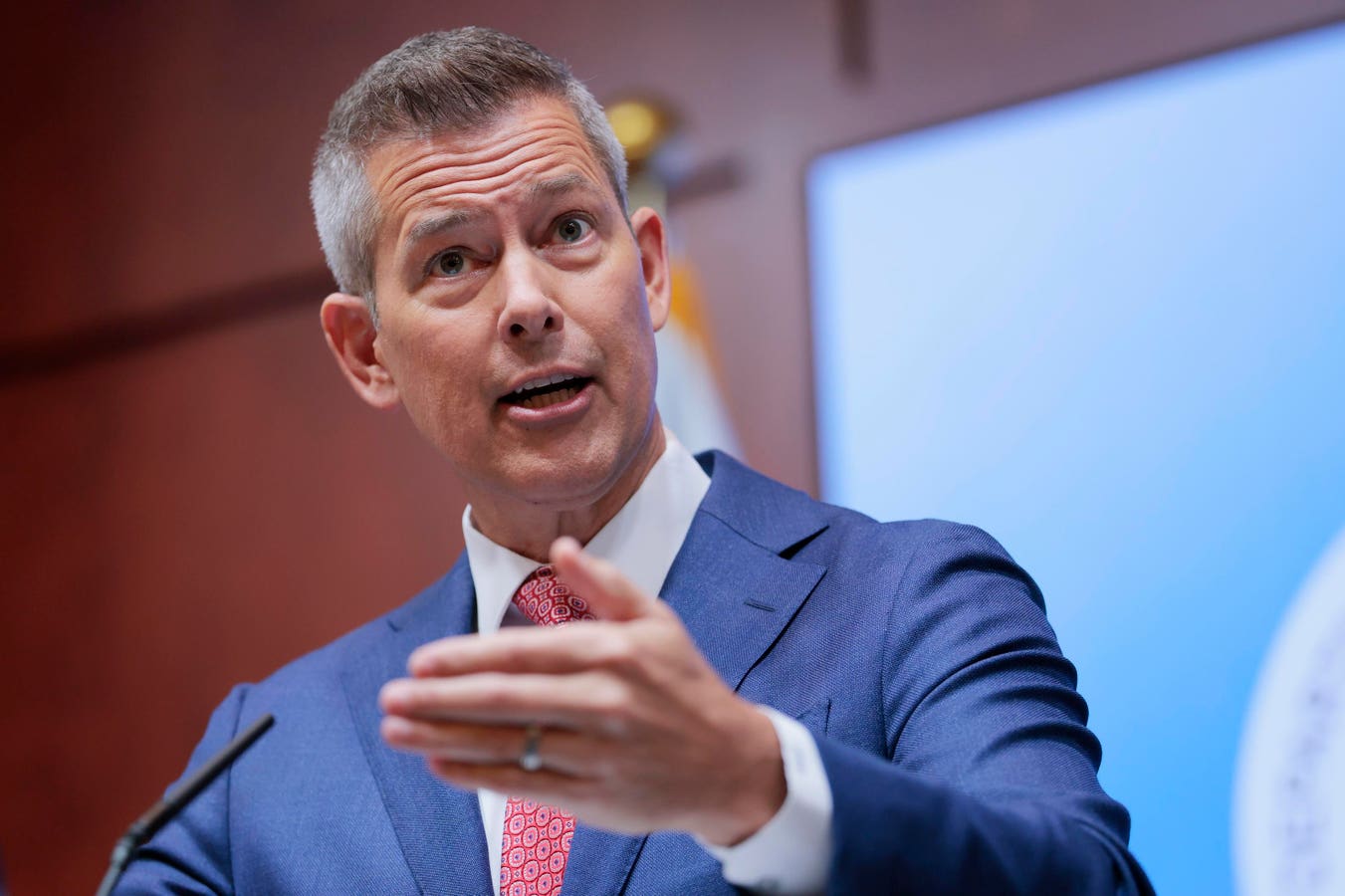Topline
Transportation Secretary Sean Duffy is assembling a task force to bolster outdated technology after air traffic controllers lost communication with pilots three times in two weeks at Newark Liberty International Airport, while a persistent staffing shortage continues to raise safety concerns.
U.S. Transportation Secretary Sean Duffy speaks to reporters during a news conference on Newark … More Liberty International Airport on May 12. (Photo by Anna Moneymaker)
Key Facts
The Federal Aviation Administration (FAA) has created a task force with technology and telecommunications contractors to address the tech problems plaguing Newark Liberty International Airport, which are being caused by a failure of the relay system feeding data from New York to Philadelphia, U.S. Transportation Secretary Sean Duffy told reporters Monday afternoon.
Duffy said that he planned to reduce the number of flights at Newark as a safety measure.
As few as three air traffic controllers were scheduled to work on Monday evening at the Philadelphia facility, far below the target of 14 controllers, the FAA told the New York Times.
In the past two weeks, Newark has experienced three equipment failures, including an air traffic control equipment outage Sunday that lasted about 45 minutes and two telecommunications outages on April 28 and May 9, during which air traffic controllers lost contact with planes they were guiding to land at the airport.
A “current veteran controller” who wished not to be identified by name told NBC News that controllers guiding planes into Newark airport have lost radar contact with pilots “at least eight or nine times in recent months” and on at least two other occasions since August.
What Travelers Should Know If They Are Flying Through Newark:
Newark Airport is open Tuesday, but a ground delay is expected to limit the number of flights in and out, according to the FAA’s National Airspace System dashboard. Some airlines are issuing travel waivers allowing you to rebook a flight without a change fee. United Airlines, for example, which has a major hub at Newark, is allowing passengers flying in or out of the airport through May 23 to switch to a flight on another day at no extra charge. American Airlines’ travel alert covers flights scheduled through Newark up until May 14 and JetBlue Airways allows passengers flexibility for flights scheduled through Newark until May 31. It’s always a good idea to download your airline’s app to monitor your flight’s status and sign up for text notifications. In the event of a delay or cancellation, the app is often the fastest path to rebooking another flight. FlightAware can let passengers know if your plane is on schedule. Enter your flight information, and then click “Where is my plane now?” under the flight number. You’ll be able to see if the plane is ahead of schedule, on time or behind schedule and can take action accordingly.
Is It Safe To Fly?
Officials at the FAA and the National Transportation Safety Board insist that it is. On Monday, United Airlines CEO Scott Kirby wrote a note to customers to reassure them “every United pilot is trained for a wide range of potential issues, including radar or communications outages,” linking to a video of the managing director at the airline’s flight training center explaining what happens if there is a loss of communication between air traffic controllers and pilots. “There are several layers of safety protocols in place, including additional facilities that will provide radar services and a safe handoff to the tower facility in the event of an equipment outage,” Captain Miles Morgan says in the video. “On the flight deck, we have advanced safety technology that allows pilots to see other aircraft around us.”
What Is The Faa Doing To Ensure Flying Is Safe At Newark Airport?
To compensate for a shortage of air traffic controllers and the recent tech failures, FAA is managing the flow of traffic at Newark with a “ground delay,” which limits the number of flights in and out of the airport. In addition, United Airlines,\ has cut 35 roundtrip flights per day from its Newark hub. Appearing on NBC’s “Meet the Press” Sunday morning, Duffy said Newark “100%” needs to scale back its operations, noting: “We have less controllers working the Newark airspace right now. And, you know, we’re having these–these glitches in the system. So we slow it down and keep people safe, that’s what we do.”
Key Background
Newark Airport is facing a perfect storm of challenges, including unreliable technology at the terminal radar approach control tower (TRACON) at Philadelphia International Airport, which is responsible for directing aircraft in and out of Newark Airport. In addition, the airport has a persistent shortage of air traffic controllers and a runway closure. Air traffic controllers at the Philadelphia TRACON had been operating with 22 fully certified controllers and 21 controllers and supervisors in training, but four air traffic controllers have been on trauma leave since the April 28 incident.
Who Is To Blame For The Crisis At Newark Airport?
“The blame belongs with the last administration,” Duffy told reporters, adding that his predecessor, Pete Buttegieg and former President Joe Biden “did nothing to fix the system that they knew was broken.” But the FAA’s two major problems—antiquated technology and a persistent air traffic controller shortage—have dogged five administrations over more than two decades. In 2003, the George W. Bush administration initiated a plan to establish NextGen, a computerized system to modernize air traffic control. But during the administrations of Obama, Trump and Biden the initiative got mired down by budgetary and logistical challenges and a culture of incrementalism. Likewise, the National Air Traffic Controllers Association (NATCA) has warned of a lack of fully certified controllers for over a decade, as staffing was hampered by repeated government shutdowns and the COVID-19 pandemic, but the FAA is still short 3,500 controllers.
Could Air Traffic Control Outages Happen At Other Airports Besides Newark?
“What you see in Newark is going to happen in other places across the country,” Transportation Secretary Sean Duffy said during an interview Sunday on NBC’s “Meet the Press With Kristen Welker, adding, “I’m concerned about the whole airspace.” Duffy characterized the equipment as safe, but old. “We have redundancies, multiple redundancies in place to keep you safe when you fly,” Duffy told Welker. “But we should also recognize we’re seeing–we’re seeing stress on an old network, and it’s time to fix it.”
What Is The Faa Doing To Fix Its Outdated Technology?
Last week, the Federal Aviation Administration (FAA) unveiled a plan to upgrade the FAA’s communications system, the Standard Terminal Automation Replacement System (STARS). At this time, telecommunications lines feed data from STARS in New York to the TRACON at Philadelphia International Airport, where controllers handle Newark arrivals and departures. The FAA’s plan involves adding three new, high-bandwidth telecommunications connections between the New York-based STARS and the Philadelphia TRACON “to provide more speed, reliability and redundancy,” and to establish a STARS hub at the Philadelphia TRACON so that it no longer depends on a telecommunications feed from the New York STARS hub. The improvements will be implemented “in the coming weeks and others in the coming months, and all by the end of the year,” an FAA spokesperson told Forbes. Duffy has called for Congress to allocate tens of billions of dollars to overhaul America’s strained air traffic control system and replace its antiquated technology. Duffy said his agency would build a new air traffic control system “in three to four years” but needed Congress to make that happen, adding, “we need all of the money up front.”
What Is The Faa Doing To Address The Air Traffic Controller Shortage?
The agency continues to be challenged by a decades-long shortage of air traffic controllers. In February, Duffy unveiled a plan to “supercharge” the hiring of air traffic controllers to shave “more than four months off the old process.” But it can take nearly four years to become a certified ATC, including spending several months at the FAA Academy in Oklahoma City, then completing up to three years of on-the-job experience before becoming certified, according to the FAA website.
Further Reading
Newark Airport Crisis: FAA Announces Upgrade Plan For Communication System (Forbes)











